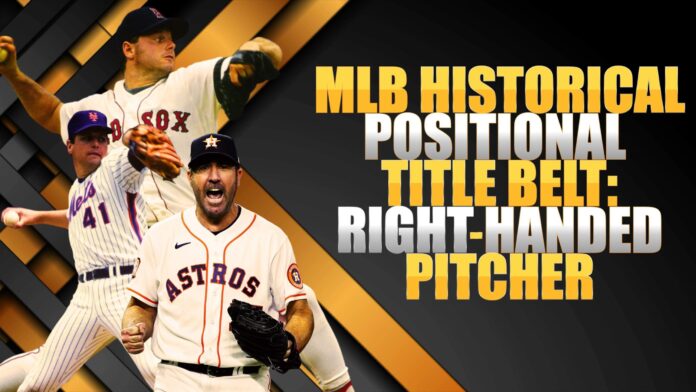Have you ever wondered who the best baseball player alive was in any given year? No? Well, I have. Further, I’ve wondered who the best player actively playing was. One way to answer that question is to look at who played best in that particular year, which is easy to do. Pick your favorite metric or award and see who was on top. However, a more interesting way, in my opinion, is to see what active player in any given year was the best player for his career. In other words, the best player ever, Babe Ruth, was the best active outfielder for his entire career from 1914-1935. The year before Ty Cobb was the best and the year after Mel Ott.
This series of articles will lay out the timeline for each position, starting with pitchers, and moving through the position players. Here are the rules: first, a player’s full career value is applied to every year they are active, so as mentioned about Ruth is the full weight of his dominating self from the very beginning. Why? Cuz the guys playing in 1915 might not have known it, but they were competing with the greatest ever and I think that’s a cool idea. Second, by career value I mean a proprietary stat I’m calling wcWAR+. Basically, it’s a combination of the two most popular wins-above-replacement metrics (fWAR and bWAR) weighted to era and position with a boost for awards. Finally, this doesn’t really tell us who played the best in 1946 or 1972 but it does tell us who the best active player was, at least in a certain kinda way.
First up, right-handed pitching. Specifically, starters, though relievers rarely accumulate enough value to matter. To the list!
Pre-Deadball 1871-1900
At the beginning of time or around 1871, baseball, more or less as we know it, became a professional sport. The first 29 years are known as “Pre-Deadball” because they preceded the next era, “Deadball” and came before the first World Series. It’s like Baseball’s B.C. The first great to stand out was Bobby Mathews.
Bobby Mathews 1871-
Mathews played from 1871 to 1887 and put up a respectable 104.4 wcWAR+ (I’d argue 100+ is a good line for the Hall of Fame). He finished his career with 4956.1 IP and a sparkling 2.89 ERA. He fell just 3 wins short of 300 and had some eye-popping season numbers. In 1874, for the New York Mutuals, he went 42-22 with a 2.30 ERA over 578.0 IP. Then in 1885, for the Philadelphia Athletics, he had his career high in fWAR at 9.0 with a 30-17 record and 2.43 ERA over 422.1 IP. He didn’t have a ton of competition, back at the beginning of time as we know it, but he was better than fellow HOF trailblazer Al Spalding. He reigned supreme for the first four years until…
Pud Galvin 1875-
…the debut of one Pud Galvin. James Francis Galvin was either called Pud because he was pudgy or because he turned opposing batters into pudding…biographers disagree. Galvin put up enormous counting stats with multiple seasons over 600 IP, including a mindboggling year in 1884 with the Buffalo Bisons in which he had a 1.99 ERA over 636.1 IP, K’d 369 batsmen, and went 46-22. He was the first man to cross the 300-win barrier finishing at 364-310 and logged 646 complete games, almost 94% of his starts. He snatched the crown from Mathews with his 147.0 wcWAR+, and held it for 5 years until the debut of…
Tim Keefe 1880-
Timothy John Keefe. Like the two before him, Keefe had huge numbers. He eclipsed 40 wins twice and finished with a 342-225 record. He had a minuscule 2.62 ERA over 5047.2 IP and twice completed 400 IP with an ERA under 2.0. He tossed 39 shutouts and exceeded 300 K’s in three separate seasons. His 171.1 wcWAR+ was good enough to hold the crown for two years. Then along came…
John Clarkson 1882-
…two-way star John Clarkson. Among pitchers, there have only been 20 seasons to reach 10+ fWAR. Clarkson has three of them. Keefe & Galvin had one each. In 1885, he led the Chicago White Stockings with 53 wins and a 1.85 ERA over 623.0 IP with 308 K’s. Then in 1887, he went 38-21 with 237 K’s over 523.0 IP. Finally, in 1889, he won 49 games and K’d 284 over 620 IP. The Pre-Deadball era’s greatest pitcher, Clarkson held the title belt all the way to 1890 before handing it over to a guy you may have heard of.
Deadball 1901-1919
The Deadball era was known for speed, bat-to-ball skills, terrible fields, horrible defense, and dominant pitching. Nobody dominated more than the era’s first and greatest ace:
Cy Young 1890-
Denton True Young nicknamed Cyclone, and now eternally known as Cy, is by many metrics the greatest hurler of baseballs the world has ever seen. He holds the all-time record in 8 different categories; though hits, earned runs, and losses aren’t exactly flexes as much as evidence of his enormous longevity. He tallied an impossible 511 W’s and an equally absurd 7356.0 IP, facing 29,565 batters. He did all that with an ERA of 2.63, which equals an ERA+ of 138, 38% better than the average of his time. Not only did he pitch forever, he pitched really well forever. He was worth at least 5.5 fWAR (low end of MVP level) every year from 1891-1908 topping out at 8.0 in 1905 with 38 W’s, 210 K’s, and a 1.82 ERA over 320.2 IP for the Boston Americans. He held the crown, with his astronomical 303.7 wcWAR+ until he retired in 1911, a whopping 22 years. Other Pre-Deadball & Deadball greats such as Kid Nichols, Tony Mullane, Amos Rusie, Old Hoss Radbourn, and Jim McCormick all took a backseat to the Cyclone. A recognizable name rose up during Cy’s career, fireballer Christy Mathewson, and he put up a huge 210.4 wcWAR+ but he was covered over by Cy and the next two names on the list:
Walter Johnson 1912-
The Big Train was perhaps the greatest pitcher ever in an era of giants. Johnson’s 150 Black Ink score is the highest ever for a pitcher and he led in all the categories – wins, ERA, complete games, shutouts, IP, K’s, FIP, WHIP, etc. He also won 2 MVPs, 3 triple crowns, 5 ERA titles, and holds the all-time record with 110 shutouts. His 3509 K’s is 9th all-time and 3rd for lefties. The crown sat upon his head until he retired nearly a decade into the Liveball era. He faced Ruth 107x and K’d him 25x but also of his 97 allowed HRs, 7 were the Bambino…oh to have watched those matchups! (shout out to fenwaypark100 for the research).
Grover Cleveland “Pete” Alexander 1930-
Grabbing an in-between year as the other great Ace of the Deaball era was Grover Cleveland Alexander. Nicknamed Pete, Alexander tallied the 2nd most black ink for a pitcher in history. Black Ink is a score developed by Bill James which represents leading the league in a particular category, Alexander scored 130, the average HOFer only has 40. He threw 90 shutouts and led the league 7x, he collected 3 pitching triple crowns (lead in ERA, K’s, and W’s), and finished with a 2.56 ERA over 5190.0 IP, an ERA+ of 135. His wcWAR+ of 225.0 held the crown for 19 years till he retired in 1930. Between Cyclone, Big Train, and Pete, the last half of the Pre-Deadball era, the entire Deadball era, and the first half of the Liveball era were covered. Dominance.
Liveball 1920-1941
A belt-holder at a different position symbolized the transition from Deadball to Liveball as he began hitting baseballs over fences in great numbers. The twenty-one years that followed saw the sport grow in popularity before reaching a critical point in American history and pushing into the next era, Integration. After “Pete” retired, Liveball needed its next ace, and it had a star who had begun his career back in 1915 but now had risen to fill the vacuum from Alexander’s retirement.
Dazzy Vance 1931-
The man known as Dazzy, Charles Arthur Vance, was second fiddle to Alexander for most of his career. He debuted all the way back in 1915, won the 1924 MVP, and led the league in strikeouts seven straight seasons from 1922-28. The dominance accumulated 128.2 wcWAR+ and held the belt through his retirement in 1935. It’s good he hung it up then because he’d have lost the crown anyway to the Heater from Van Meter.
Bob Feller 1936-
Feller was born in Van Meter, Iowa and the only thing that slowed him down was World War II. Despite spending three of his prime seasons (‘42-44) serving his country, Feller racked up 2581 K’s over 3827.0 IP with a 3.25 ERA, 22% better than average. In ‘46 he set his career high in fWAR with 9.6 whild putting up a 2.18 ERA over 371.1 IP with 348 K’s. His wcWAR+ of 133.5 was good enough to keep the belt for 12 seasons. During that time, baseball’s color barrier was broken, and we moved into the Integration era.
Integration 1942-1960
Jackie Robinson, Larry Doby, Roy Campanella, Hank Aaron, Willie Mays, Satchel Paige and so many more burst into the major leagues as the color barrier fell. Their brilliance and impact was immense in its own right and furthered the disappointment that so many greats toiled in obscurity behind the veil, such as Josh Gibson, Bullet Rogan, and Oscar Charleston.
Robin Roberts 1948-
Taking over from Feller was a righty exemplified the idea of a workhorse starter. Robin Evan Roberts led the league in starts, complete games, and innings pitched for four consecutive seasons. He racked up an impressive 64 Black Ink points and had 2357 K’s over 4688.2 IP. His 166.0 wcWAR+ held the title against significant contenders such as Jim Bunning and Don Drysdale but he eventually lost it in 1959 when a young man from Omaha debuted.
Bob Gibson 1959-
Bob Gibson played his entire career for the St Louis Cardinals and it was a dominant career. He collected 2 Cy Young awards and the 1968 MVP when he went 22-9 with a 1.12 ERA over 304.2 IP. That was good for a 258 ERA+, 258% better than the average pitcher. Some consider that the best year for any pitcher, ever. In terms of fWAR, he was even better in 1970 with 274 K’s and a 2.29 FIP over 294.0 IP. He held the title as baseball transitioned yet again into the Expansion era but was quickly overtaken.
Expansion 1961-1976
In 1961, the Los Angeles Angels and Washington Senators (Texas Rangers) joined the league. Then in ‘62 the New York Mets and Colt .45’s (Houston Astros) joined. Again in 1969 four more teams were added, the Kansas City Royals, Montreal Expos, San Diego Padres, and Seattle Pilots (Milwaukee Brewers). There have been three other expansion years but the sudden influx of major league roster spots in the 60’s and 70’s had competing effects of diluting the talent pool and giving more players opportunities to shine. Three different pitchers held the belt during the era, Bob Gibson for year one before it was stolen by the Spitballer.
Gaylord Perry 1962-
Most people would be appalled to think that Gaylord Perry could be better than Bob Gibson. And perhaps, in a single season, they’d be right. Their careers overlapped and Gibson certainly appeared better head-to-head. But Gibson’s career ended in ‘75 while Perry kept going all the way into the 80s to 1983. He had enormous longevity but also extreme heights such as his ‘72 season in Cleveland when he had a 1.92 ERA and 234 K’s over 342.2 IP. A pair of Cy Young awards and a wcWAR+ of 192.1 kept the crown on Perry’s head until the arrival of Tom Terrific.
Tom Seaver 1967-
The Franchise arrived to much fanfare in New York and won the Rookie of the Year in ‘67 and a Cy Young in ‘69. He added two more Cy trophies before being traded for four players to the Reds. He’d never recreate the utter dominance of his 20s but remained an above-average pitcher by ERA+ for 20 years. He finished his career with a 2.86 ERA over 4782.2 IP and 3640 K’s which is 6th all-time. His 209.4 wcWAR+ held off Bert Blyleven’s also excellent 204.8 before handing off to the next era’s superstar, the Rocket.
Free Agency 1977-1993
As the Mariners and Blue Jays were added signaling the end of the expansion era in ‘77, the reserve clause fell in ‘75, and a new Basic Agreement went into effect in ‘76, Players were now free to move around the league. It was a right-handed pitching great who first took advantage, in 1974 Catfish Hunter left the Athletics and signed with New York. The era was dominated by Seaver at first and then by the greatest modern right-hander of all-time, and one of the most controversial of baseball’s stars.
Roger Clemens 1986-
William Roger Clemens was unhittable. He dominated an era known for big offensive numbers and even bigger offensive players. He won a record seven Cy Young awards, led the league in ERA seven times, bagged the ‘86 MVP award, and held the right-handed starting pitcher title belt for a record 24 years. Only Cy Young himself racked up more than Clemen’s 298.9 wcWAR+ and his 4670 strikeouts is second only to Nolan Ryan (who was boxed out of a title belt by Perry, Seaver, and Clemens). The Rocket pitched all the way into the new millennium, past the work stoppage of ‘94, and into the Wild Card era.
Wild Card 1994-2011
After the disaster, which I blame on Bud Selig personally, of the ‘94 stoppage, the players and owners agreed to add more playoff teams, restructure the league, and it took the shape of the “modern” game. This era could also be called the Steroid Era but the title belt pitcher who most represents Steroids was Clemens so I went with Wild Card. It’s title belt holders were almost subsumed by Clemens but as the truth about PEDs became known, a couple of Free Agency/Wild Card stars outlasted him to get a year each with the crown.
Greg Maddux 2008-
Pedro Martinez 2009-
Mad Dog and Pedro were utterly brilliant throughout the 90s and early aughts. Maddux is still the only pitcher to win four-straight Cy Young awards and he also holds the record for Gold Gloves as a pitcher with 18. He outlasted Clemens by one season for his title belt year and then handed it off to Pedro who went yet one further. Pedro had probably the greatest single season in right-handed pitching (any pitching?) history in 1999 when as a Red Sock, he had a 1.39 FIP, 2.07 ERA, and 313 K’s over 213.1 IP. In the middle of the steroid era. Insanity.
Expanded Playoffs 2012-Now
Coming up with a name for the current era was difficult. It hasn’t quite been long enough to truly evaluate the years since they added another playoff team. Rules have changed, teams have changed names and divisions, and the game has rapidly transformed into an extremely efficient display of athleticism and power. This modern era has been had several great pitchers including Felix Hernandez, Zack Greinke, Max Scherzer, and Jacob deGrom but only one can sit on the throne.
Justin Verlander 2010-
Verlander debuted in 2005 and took over the top dog spot after Pedro retired. He has an MVP, 3 Cy Young awards, and two ERA titles. His best season may have been 2022, when he logged a 1.75 ERA over 175.0 IP, 120% better than average. He’s also climbed to 13th on the all-time K list with 3268 and is still providing quality innings (when healthy) at age-40.
So there you have it, the right-handed starter title belt holders:
Bobby Mathews 1871-1874
Pud Galvin 1875-1879
Tim Keefe 1880-1881
John Clarkson 1882-1889
Cy Young 1890-1911
Walter Johnson 1912-1929
Grover Cleveland Alexander 1930-1930
Dazzy Vance 1931-1935
Bob Feller 1936-1947
Robin Roberts 1948-1958
Bob Gibson 1959-1961
Gaylord Perry 1961-1966
Tom Seaver 1967-1985
Roger Clemens 1986-2007
Greg Maddux 2008-2008
Pedro Martinez 2009-2009
Justin Verlander 2010-2023







